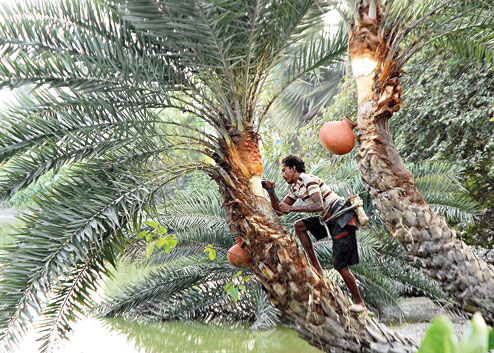Almost every part of the Wild Date Palm tree is useful but it is most loved for the jaggery that it produces. The syrup form — nolen gur — or the moulded blocks of patali gur make our mouths water and jaggery is one of the most awaited products of winter in Bengal.
Also known as Sugar Date Palm, the khejur tree is native to the relatively dry parts of the Indian subcontinent and Sri Lanka and is abundant in the coastal districts of Bengal.


It is scientifically known as Phoenix sylvestris, in which the word “phoenix” means purple in Greek — a name given to the date on account of its colour — and sylvestris means wild.
The Wild Date Palm is hardy and extremely adaptable to various ecological conditions although it is rarely cultivated in the garden as ornamental plant. It is rare in Salt Lake but some are found in the adjacent fringes.
How it looks
The khejur tree has a stem that is generally curved and a plumose crown reaches up to a height of 18m. Its bark is greyish, sometimes nearly black, rough and uneven. The bark is covered with the stumps that get created after the leaves fall off. The tree generally has a mass of exposed air-roots extending up to a meter or so above the ground.
The leaves of this tree are about 45cm long and greyish-green in colour. The lower leaves are arched, the petioles short, flattened and they are strongly spined at the margin. The thin pointy leaflets are folded neatly into a “V” shape where they are attached to the main leaf stem. The leaves emerge at irregular spots on the stem.
The flowers are three-petalled and fragrant. The male and female flowers appear on separate trees during the months of March and April. Male flowers are white, about 6mm long and the calyx has three prominent points. The calyx of female flowers are cupular with three prominent points too.
In the first stage the flower buds remain enclosed with a woody sheath, which splits into two halves as the flowers develop. The male flowers are slightly larger.

Fruits are about the size and shape of an Olive and about 3cm long and 1.5cm broad in the middle. At first the fruits remain green, later turning into orange-yellow and finally a deep red brown after ripening. Each fruit contains a small quantity of pulp and a large grooved seed.
High on utility
One of the most useful palms in India, Wild Date Palms are chiefly valued for jaggery. Their sugary sap is extracted in winter from incision made just below the leaves.
Generally the tapping is done at night with an intervening period of rest for the tree. Freshly tapped sap of the Wild Date Palm is as clean as water. It is a delicious drink with 12 to 15 per cent sugar and is rich in vitamins. Freshly tapped juice tends to ferment quickly but application of lime in the receiving pot delays the fermentation.
After sufficient boiling, the juice becomes a thick syrup called jaggery (nolen gur). It can be condensed further and moulded in suitable blocks too and this becomes patali gur. This too is in great demand in the market. Delicious sandesh and moa are also prepared from nolen gur and people try to store it to consume round the year. On an average, a Date Palm tree yields about 40kg of jaggery per season.

Dry leaves of the palms are woven into floor mats known locally as chatai. Sometimes its leaves are crushed and the beaten leaflets are made into brooms. Old unproductive stems are cut into pieces and used as fuels for burning tiles too. The fruits and seeds are used in folk medicine as tonic and crushed roots of this palm are used for relieving toothache.
I shall conclude this article by sharing the anecdote of how I saw an unusual-looking Wild Date Palm tree once that had multiple trunks. I had seen this tree on Taki Road (between Barasat and Basirhat) in the early 1950s. While usually this tree has a solitary stem, this particular tree had six trunks! At that time, I would frequently travel by that road and once I even stopped to photograph it but unfortunately the picture has not stood the test of time.
I had seen another such tree, with three trunks, in 2006, in a burial ground on Andul Road in Howrah, a five-minute drive from Vidyasagar Setu.
? To be continued
- S K Maity is a patron of Bidhannagar Horticultural Society and a civil engineer residing in FC Block, shares tips on designing one’s green patch so as to attract winged friends











